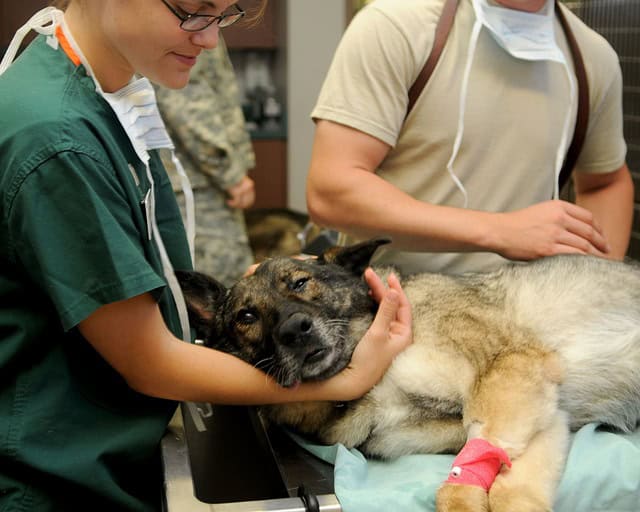Shaking and trembling are common in dogs after surgery but are also potential signs of complications. There are many possible causes of a dog shaking after anesthesia and surgery.
While post-surgical shaking is frequently harmless, it can sometimes indicate an underlying issue requiring veterinary attention. Following medical procedures, this article outlines the main reasons why dogs shake and tremble.
Brief episodes of shivering or trembling while emerging from anesthesia are typical and not a significant concern. However, if the shaking persists, worsens, or occurs alongside other symptoms, it could point to a problem.
Knowing the various explanations for this behavior will help dog owners determine when it’s within the range of normal recovery responses or may require urgent treatment.
Monitoring your dog closely after surgery and consulting your vet if you have any worries is essential.
Pain and Discomfort
It’s common for dogs to shake or tremble after surgery due to pain and discomfort. The surgical procedure can cause inflammation and pain around the incision site or in the manipulated muscles and tissues.
Even minimally invasive laparoscopic procedures can leave dogs feeling sore.
Post-operative pain can cause involuntary muscle tremors and shakes as the body reacts. Surgical trauma stimulates nerve endings and triggers the release of neurotransmitters that cause the muscles to contract and spasm involuntarily.
This is the body’s way of signaling something is wrong and protecting the injured area.
Some degree of post-op shaking due to pain is normal. However, excessive, prolonged, or worsening tremors can signify a more serious issue.
It’s essential to monitor your dog closely and consult your vet if you have any concerns about pain or discomfort after surgery. They may prescribe pain medication to help control post-surgical pain and trembling.
Anesthesia Wearing Off
Shaking and trembling after surgery as the anesthesia wears off is very common and normal. Anesthesia drugs given for surgery cause muscle relaxation and sedation.
As these drugs leave the body, the muscles can spasm and tremble as they start waking up from the anesthesia. The shaking and shivering are a reflex and a sign that the anesthesia is wearing off.
This muscle trembling is often most noticeable during the first few hours after surgery. However, some mild shaking that comes and goes can continue for 24 hours or so after anesthesia as the drugs prominent the system.
The trembling and muscle spasms are involuntary reflexes and the dog is not cold or in distress. Owners should not be alarmed if they notice their dog shaking, shivering, or trembling in the hours after coming home from surgery.
A calm environment and supportive care will help the dog as the anesthesia wears off. Let your vet know if shaking is prolonged or accompanied by other symptoms like vomiting.
Otherwise, the anesthesia-related muscle tremors are temporary and expected. The medication should be gone within a day, and the involuntary shaking and twitching will stop.
Low Body Temperature
It’s common for dogs to have a lower-than-normal body temperature after anesthesia and surgery. This hypothermia or lower body temperature can make them shiver and tremble as their body tries to warm itself back up.
Hypothermia occurs under anesthesia, partially due to the medication’s effects but also because patients lie still on a metal surgical table.
This causes body heat to be lost to the surfaces they’re touching. Additionally, surgery requires the surgical site to be clipped and cleaned, exposing the skin.
It’s essential to keep your dog warm following any surgical procedure. Provide a warm blanket or bed away from drafts.
Gently rub your hands along your body to generate warmth through friction. Also, offer a heating pad set on low underneath the bedding.
Monitoring their temperature at home and taking steps to maintain it in the ideal range will help them resolve the shivering.
Let me know if you would like me to expand or modify the section in any way.
Medication Side Effects
Some medications given before, during, or after surgery can cause tremors and shaking as a side effect.
Pain medications like opioids and NSAIDs can potentially lead to tremors in dogs. Opioids like morphine, hydromorphone, fentanyl, and tramadol work by binding to opioid receptors in the brain and spinal cord, which block pain signals.
However, they can also overstimulate the central nervous system, leading to side effects like shaking, tremors, and seizures in some cases.
Morphine, in particular, is linked to shaking after surgery in dogs. It has a narrow therapeutic index, meaning the line between practical and toxic doses is small. Too high of a dose can overexcite the central nervous system.
Tremors from morphine may subside on their own as the medication leaves the body. But if shaking seems severe, veterinary attention is warranted.
Other pain relievers, such as NSAIDs and steroids, also have potential neurological side effects. NSAIDs inhibit prostaglandins, which control inflammation and pain, but they may also affect platelets and blood clotting.
Corticosteroids suppress the immune system and inflammation, but long-term use can cause various side effects throughout the body. Both NSAIDs and steroids should be used cautiously under veterinary supervision.
Monitor your dog closely after surgery and alert the vet to any concerning medication reactions. Shaking and tremors that start or worsen after your dog’s prescription drugs can signal an adverse reaction.
Your vet may adjust dosages or switch to other pain management options to help resolve medication-induced tremors. With proper management, your dog should recover comfortably after surgery.
Anxiety and Stress
Surgery is stressful for dogs. The unfamiliar smells and sounds of the veterinary clinic, being separated from their owner, and the procedures involved with surgery can all cause anxiety in dogs.
The stress hormone cortisol is released in response to surgery, and dogs may tremble or shake as a physical manifestation of their anxiety. The shaking is not from pain or cold but rather adrenaline and cortisol flooding their system.
Some dogs are more prone to anxiety than others. Shy, timid, or sensitive dogs are more likely to feel anxious about surgery.
The shaking and trembling are their anxious response to the stress. It’s similar to how humans may fidget or bounce their legs when nervous or worried.
Try to minimize your dog’s anxiety pre and post-surgery by keeping routines consistent, using calming pheromones, and providing affection.
The anxiety and shaking should subside with time as your dog recovers and adjusts. If anxiety seems severe or persists longer than expected, discuss options with your vet, like prescription anti-anxiety medication.
Infection
After surgery, dogs are at an increased risk of developing an infection around the incision site or internally.
This is because the skin’s protective barrier has been disrupted, allowing bacteria to enter the body more easily.
The immune system also becomes weakened due to the stress of surgery and anesthesia. This makes it harder for the dog’s body to fight off bacteria and prevent infection.
Signs of infection after surgery include:
- Redness, heat, swelling, or discharge around the incision site
- Fever
- Chills – this is the body’s response to a rise in temperature
- Lethargy or lack of appetite
- Pain which may worsen
A fever and chills indicate the dog’s immune system is trying to fight off an infection. A high fever is the body’s way of creating an inhospitable environment for bacteria. But fever can also be dangerous if it becomes too high.
It’s essential to monitor the incision site closely and check for other signs of infection. Contact your vet promptly if you notice these signs, as antibiotic treatment may be needed.
Leaving an infection untreated can allow it to spread and, in severe cases, lead to sepsis.
So, while fever and chills are normal responses to infection, they also signify a serious medical issue that requires veterinary attention after surgery.
Monitoring your dog closely and contacting your vet at the first sign of infection is crucial to preventing complications.
Low Blood Sugar
One potential cause of shaking after surgery is low blood sugar, also known as hypoglycemia. This occurs when blood sugar levels drop too low.
Dogs are prone to low blood sugar after surgery for a few reasons:
- Not eating leading up to surgery. Dogs are required to fast before undergoing anesthesia, which can lead to low energy stores and dropping blood sugar levels.
- Medications are given before or during surgery. Some anesthetics and pain medications can interfere with normal blood sugar regulation.
- Stress from surgery and recovery. The stress of the procedure and healing process can prompt the release of hormones that affect blood sugar.
If blood sugar gets too low, it deprives the brain and other organs of their primary energy source. This can lead to neurological symptoms like:
- Tremors or muscle twitching
- Restlessness
- Anxiety
- Weakness
- Disorientation
Tremors associated with low blood sugar are often described as fast fine muscle fasciculations. They may start and stop intermittently as blood sugar fluctuates. To stop this abnormal shaking, hypoglycemia needs to be addressed quickly.
Treatment involves restoring blood sugar levels by feeding carbohydrates or a sugar source like honey or maple syrup.
More severely low dogs may need a dextrose IV drip. Preventing crashes involves monitoring glucose and feeding small meals throughout recovery.
Nerve Damage
Nerves may accidentally become damaged or cut during surgery. This can happen with any procedure but is more common during orthopedic surgeries and other invasive operations involving bones, muscles, and nerves.
Post-surgical nerve damage can cause prolonged, uncontrollable shaking and tremors. After being severed or affected during the procedure, the nerves may be irritated, inflamed, or struggling to communicate with the brain properly.
This disruption in nerve signaling is likely the cause behind persistent post-surgery shaking.
If your dog is still shaking for several days or weeks after surgery, nerve damage is a likely culprit. Prolonged, uncontrollable shaking, tremors, and odd gait are common signs.
If the shaking continues longer than expected, make an appointment with your vet. They can run tests to diagnose nerve trauma and possible treatments.
Minor nerve damage often heals on its own with time and care. However, more severe cases may require medication, therapy, or additional procedures to address the injured nerves.
Getting your dog checked out for prolonged post-surgery shaking is extremely important. The underlying cause must be determined, and nerve damage must be treated accordingly to stop the tremors and allow proper healing.
When to See the Vet
It’s normal for dogs to shake and shiver a bit after surgery as the anesthesia wears off. However, excessive, prolonged, or worsening tremors can indicate a more serious issue. Contact your vet right away if your dog’s shaking:
- It gets progressively worse or continues more than 24 hours after surgery
- It is accompanied by other symptoms, such as whining, panting, vomiting, diarrhea, loss of appetite, lethargy, or restlessness.
- It seems to be localized to one area rather than a generalized shaking.
- Appears uncontrollable, with muscle spasms or tremors
- It prevents your dog from resting comfortably.
Any time your dog seems in distress, it’s better to err on the side of caution. Even if the vet ends up advising you to just monitor your dog’s condition at home, they can provide peace of mind and specific guidelines on what to watch for. Don’t hesitate to call them with any concerns about your dog’s recovery.

